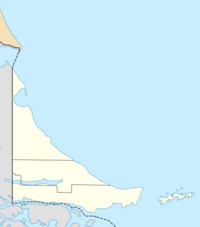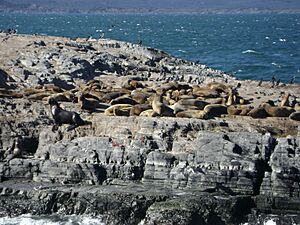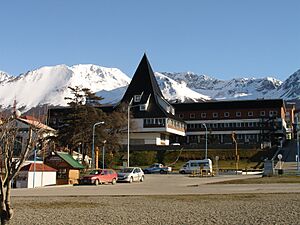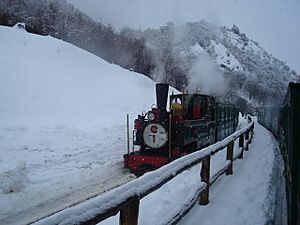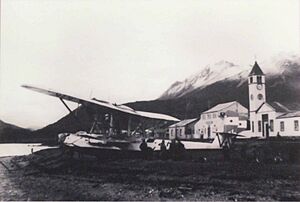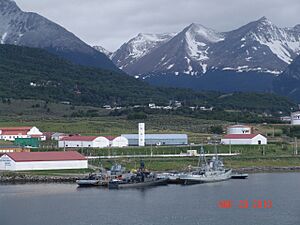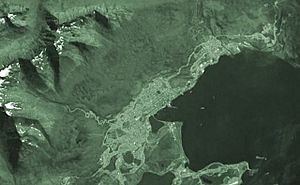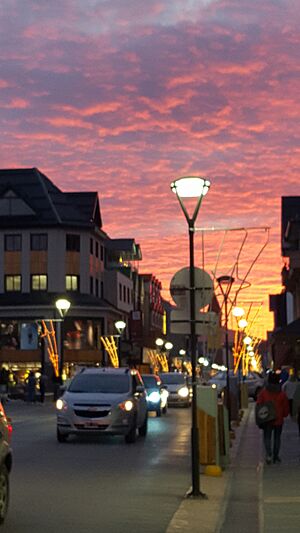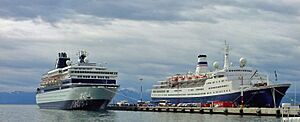Ushuaia facts for kids
Quick facts for kids
Ushuaia
|
|
|---|---|
|
City and Port
|
|
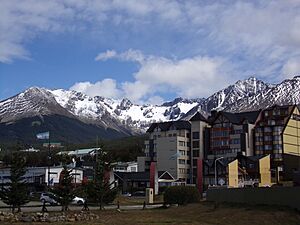
Martial Glacier
|
|
| Motto(s):
"Ushuaia, fin del mundo, principio de todo" (Spanish)
"Ushuaia, end of the world, beginning of everything" |
|
| Country | |
| Province | |
| Department | Ushuaia |
| Founded | 12 October 1884 |
| Founded by | Augusto Lasserre |
| Government | |
| • Type | Municipality |
| Area | |
| • Total | 23 km2 (9 sq mi) |
| Elevation | 23 m (75 ft) |
| Population
(2022 Census)
|
|
| • Total | 82,615 |
| • Density | 3,590/km2 (9,300/sq mi) |
| Demonym(s) | Ushuaiense |
| Time zone | UTC−3 (ART) |
| CPA Base |
V 9410
|
| Area code(s) | +54 2901 |
| Climate | ET/Cfc |
Ushuaia is the capital city of Tierra del Fuego, Antártida e Islas del Atlántico Sur Province, Argentina. With over 82,000 people, it is known as the world's southernmost city.
Ushuaia is located in a wide bay on the southern coast of Isla Grande de Tierra del Fuego. It is surrounded by the Martial mountain range to the north and the Beagle Channel to the south. The city was founded on October 12, 1884, by Augusto Lasserre. Besides being an important government center, it is a port for light industry and a popular place for tourists. Ushuaia is about 1,100 kilometers (680 miles) from the Antarctic Peninsula. It is one of five cities around the world that act as a gateway to Antarctica.
Contents
What's in a Name?
The name Ushuaia comes from the Yaghan language. It combines ush and waia, which means "bay" or "cove." So, Ushuaia means "deep bay" or "bay to the background." People from Ushuaia are called "Ushuaiense."
In Spanish, the name is pronounced "oo-SWAH-yah." The accent is on the first 'a'.
A Look Back in Time
The Selk'nam people, also called the Ona, first came to Tierra del Fuego about 10,000 years ago. The Yaghan (or Yámana) lived in the area where Ushuaia is now. They often had conflicts with the people living in the northern part of the island.
For much of the late 1800s, many people living in eastern Tierra del Fuego were not Argentine citizens. British missionaries first started a settlement in Ushuaia. This happened before Argentine officials arrived to live there permanently. The British ship HMS Beagle reached the Beagle Channel on January 29, 1833.
The city's name, Ushuaia, first appeared in reports from the South American Mission Society in England. A British missionary named Waite Hockin Stirling was the first European to live in Ushuaia. He stayed with the Yámana people from January to September 1869. In 1870, more British missionaries arrived and set up a small community. The first marriage took place the next year.
The first house in Ushuaia was built in 1870 for Reverend Thomas Bridges. It had three rooms. One room was for his family, one for a Yámana couple, and the third was a chapel. Thomas Bridges learned the Yaghan language very well. He even wrote a dictionary of the Yaghan language. The original copy of his dictionary is now in the British Museum.
In 1873, Juan and Clara Lawrence, who were Argentine citizens, came to Ushuaia to teach school. That same year, Julio Argentino Roca, who later became Argentina's President, suggested building a penal colony (a prison settlement) there. This was to encourage more Argentines to live in the area and help Argentina control Tierra del Fuego. However, serious efforts to build the town and its prison only began after a border agreement between Chile and Argentina in 1881.
In the 1880s, many people came to Ushuaia looking for gold, but there wasn't much to be found. On October 12, 1884, Augusto Lasserre officially created the sub-division of Ushuaia. In 1885, Ushuaia was named the capital of Tierra del Fuego. However, the Argentine government did not officially recognize Ushuaia as the capital until 1904.
Ushuaia faced several sicknesses, like typhus and measles, which greatly reduced the native population. The first census in 1893 counted 113 men and 36 women living in Ushuaia. By 1911, most of the Yámana people had disappeared, and the mission closed. By 1914, the population had grown to 1,558 people.
The prison received its first inmates in 1896. These were mainly prisoners from Buenos Aires. A separate military prison opened nearby in 1903. The two prisons combined in 1910. The prison was meant for serious criminals. Escaping from Tierra del Fuego was very hard. The prisoners helped build the town using wood from the nearby forest. They also built a railway to the settlement. This railway is now a tourist attraction called the End of the World Train (Tren del Fin del Mundo). It is the southernmost railway in the world.
The prison closed in 1947. After it closed, it was used by the Ushuaia Naval Base for storage and offices until the early 1990s. Later, it became the Museo Maritimo de Ushuaia (Maritime Museum of Ushuaia).
The naval base in Ushuaia was used during the Falklands War in 1982. The Argentine cruiser ARA General Belgrano, which was later sunk by the British, sailed from the Port of Ushuaia. A memorial was built there in 1996.
Geography and Climate
Ushuaia is located on Ushuaia Bay, about 6 meters (20 feet) above sea level. It is surrounded by the Andes Fueguinos mountains to the west, north, and east. It is the only city in Argentina that you reach by crossing part of the Andes mountain range.
Ushuaia has long been called the southernmost city in the world. There are smaller settlements further south, like Puerto Williams in Chile, which has about 2,000 residents. But Ushuaia is much larger and more important as a center for people, business, and culture. So, it is still considered the southernmost city.
Ushuaia's Weather
Ushuaia has a mild tundra climate. This means it's cool but not extremely cold all year round. The average temperature stays above 0°C (32°F) and below 10°C (50°F). The plants around the city are mostly forests, not typical tundra plants.
The average temperature in the coldest month (July) is about 1.3°C (34.3°F). In the warmest month (January), it's about 9.7°C (49.5°F). The lowest temperature ever recorded was -21.0°C (-5.8°F) in July. The highest was 29.5°C (85.1°F) in January.
Ushuaia gets rain or snow about 146 days a year. It's often cloudy and foggy, with about 206 cloudy days each year. This means it doesn't get a lot of sunshine, only about 3.93 hours per day on average. Even though it doesn't get a lot of rain (about 458 mm or 18 inches per year), it is very humid, with an average humidity of 77%.
Summers are usually cloudy and windy. Daytime temperatures are around 14°C (57°F), and nights are about 5°C (41°F). Temperatures of 20°C (68°F) or more happen only a few days a year. Frost can happen in any month.
Winters are cold, with temperatures around 4.5°C (40°F) during the day and -1.4°C (29.5°F) at night. Snow, sleet, and rain showers are common. Some winters have a lot of snow that stays on the ground, while others have snowstorms followed by warmer periods.
Because Ushuaia is so far south, its climate is affected by Antarctica. The amount of daylight changes a lot throughout the year. In summer, there are more than 17 hours of daylight. In winter, there are just over 7 hours.
| Climate data for Ushuaia Airport (1991–2020, extremes 1901–present) | |||||||||||||
|---|---|---|---|---|---|---|---|---|---|---|---|---|---|
| Month | Jan | Feb | Mar | Apr | May | Jun | Jul | Aug | Sep | Oct | Nov | Dec | Year |
| Record high °C (°F) | 29.5 (85.1) |
28.9 (84.0) |
25.6 (78.1) |
22.2 (72.0) |
20.3 (68.5) |
19.0 (66.2) |
17.5 (63.5) |
18.0 (64.4) |
22.3 (72.1) |
23.7 (74.7) |
26.3 (79.3) |
29.0 (84.2) |
29.5 (85.1) |
| Mean daily maximum °C (°F) | 13.6 (56.5) |
13.6 (56.5) |
12.2 (54.0) |
9.4 (48.9) |
6.9 (44.4) |
4.5 (40.1) |
4.6 (40.3) |
5.7 (42.3) |
7.6 (45.7) |
10.1 (50.2) |
11.5 (52.7) |
12.5 (54.5) |
9.4 (48.9) |
| Daily mean °C (°F) | 9.5 (49.1) |
9.4 (48.9) |
8.4 (47.1) |
6.2 (43.2) |
4.3 (39.7) |
2.5 (36.5) |
2.3 (36.1) |
2.9 (37.2) |
4.3 (39.7) |
6.2 (43.2) |
7.4 (45.3) |
8.6 (47.5) |
6.0 (42.8) |
| Mean daily minimum °C (°F) | 5.4 (41.7) |
5.2 (41.4) |
4.6 (40.3) |
3.0 (37.4) |
1.7 (35.1) |
0.5 (32.9) |
0.2 (32.4) |
0.1 (32.2) |
1.0 (33.8) |
2.3 (36.1) |
3.3 (37.9) |
4.7 (40.5) |
2.7 (36.9) |
| Record low °C (°F) | −2.0 (28.4) |
−4.0 (24.8) |
−4.3 (24.3) |
−7.3 (18.9) |
−20.2 (−4.4) |
−18.2 (−0.8) |
−21.0 (−5.8) |
−19.6 (−3.3) |
−10.6 (12.9) |
−6.1 (21.0) |
−6.0 (21.2) |
−3.7 (25.3) |
−21.0 (−5.8) |
| Average precipitation mm (inches) | 45.1 (1.78) |
34.6 (1.36) |
38.3 (1.51) |
47.0 (1.85) |
35.3 (1.39) |
42.5 (1.67) |
35.8 (1.41) |
38.4 (1.51) |
30.5 (1.20) |
28.4 (1.12) |
38.9 (1.53) |
43.0 (1.69) |
457.8 (18.02) |
| Average precipitation days (≥ 0.1 mm) | 16.3 | 13.3 | 15.1 | 15.5 | 13.5 | 14.7 | 15.1 | 14.4 | 12.6 | 13.0 | 15.5 | 16.4 | 175.4 |
| Average snowy days | 0.2 | 0.3 | 1.0 | 4.3 | 4.8 | 9.3 | 10.6 | 10.2 | 7.7 | 5.5 | 4.4 | 1.4 | 59.5 |
| Average relative humidity (%) | 71.1 | 73.0 | 74.2 | 77.1 | 78.5 | 81.0 | 79.5 | 77.0 | 74.5 | 70.1 | 70.7 | 70.8 | 74.8 |
| Mean monthly sunshine hours | 164.3 | 146.9 | 127.1 | 96.0 | 77.5 | 45.0 | 58.9 | 93.0 | 126.0 | 155.0 | 159.0 | 155.0 | 1,403.7 |
| Mean daily sunshine hours | 5.3 | 5.2 | 4.1 | 3.2 | 2.5 | 1.5 | 1.9 | 3.0 | 4.2 | 5.0 | 5.3 | 5.0 | 3.9 |
| Percent possible sunshine | 32.0 | 34.5 | 33.5 | 31.5 | 25.7 | 18.5 | 22.5 | 27.5 | 34.0 | 37.5 | 37.0 | 28.5 | 30.2 |
| Source 1: Servicio Meteorológico Nacional (extremes 1961–present) | |||||||||||||
| Source 2: Secretaria de Mineria (extremes and percent sun, 1901–1990) | |||||||||||||
Plants and Trees
Ushuaia is surrounded by Magellanic subpolar forests. On the hills around the town, you can find native trees like Winter's bark, Hard-log Mayten, and several types of Southern Beech.
Trees in Ushuaia often grow leaning in one direction because of the strong winds. They are sometimes called "flag-trees" because of this unique shape.
Economy and Tourism
The main ways people make a living in Ushuaia are fishing, getting natural gas and oil from the ground, sheep farming, and ecotourism.
Fun Things to Do


Many tourists visit the Tierra del Fuego National Park and Lapataia Bay. You can get to the park by road or by taking the End of the World Train from Ushuaia.
The city has a museum that tells the story of the Yámana people, and the English and Argentine settlers. It also covers the years when Ushuaia was a prison colony.
You can see amazing wildlife here, including local birds, penguins, seals, and orcas. Many of these animals live on islands in the Beagle Channel. There are daily tours by bus and boat to Estancia Harberton, which was the home of the Bridges family. Tours also visit the Les Eclaireurs Lighthouse. This lighthouse is sometimes confused with the "Lighthouse at the End of the World" from a book by Jules Verne. However, that famous lighthouse is actually about 320 kilometers (200 miles) east of Ushuaia on Isla de los Estados.
Making Things in Ushuaia
Ushuaia has a strong industrial sector. The Grundig Renacer electronics factory is one of the biggest in Patagonia.
Arts and Culture
Since 2007, Ushuaia has hosted the Bienal de Arte Contemporáneo del Fin del Mundo (Biennial of Contemporary Art at the End of the World). This event brings together artists from all over the world. They think about how to make "another world possible" from the "End of the World." It also encourages students to imagine a better world.
Sports and Activities
Like in most of Argentina, football (soccer) is very popular in Ushuaia.
Ice Hockey Fun
Ice hockey is a popular sport in Ushuaia. The cold temperatures all year make it a great place to play outdoors. In 2010, the city opened an outdoor Olympic-size ice hockey rink. This was the first of its kind in South America.
Since 2005, Ushuaia hosts the yearly End of the World Cup (Copa del Fin del Mundo). This event brings together ice hockey teams from different cities.
Skiing Adventures
There are several ski areas near Ushuaia, including Glacier El Martial and Cerro Castor. Cerro Castor opened in 1999 and is the southernmost full ski resort in the world. You can ski there just 200 meters (656 feet) above sea level. The top of the mountain is 1,003 meters (3,291 feet) high. The cool temperatures allow for the longest skiing season in South America, usually from June to October.
Cerro Castor has ten lifts and 28 ski trails for all skill levels. You can also enjoy snowboarding, sledding, and snowshoeing. It is located about 27 kilometers (17 miles) north of Ushuaia.
The glacier is also popular in summer. A chairlift takes visitors up and down. Hiking trails lead from the city to the base of the glacier.
The Valley of Tierra Mayor and the Francisco Jerman Nordic Ski Area are popular places for cross-country skiing. Tierra Mayor hosts the annual Marchablanca race, and the Ushuaia Loppet, a long-distance marathon.
There have been talks about Ushuaia possibly hosting the Winter Youth Olympics in the future.
Learning and Education
Ushuaia has twelve secondary schools. Four of these schools also offer classes for adults. The Colegio Nacional de Ushuaia is one of the newer schools, designed like the Colegio Nacional de Buenos Aires.
The National University of Patagonia San Juan Bosco has a campus in Ushuaia. It offers studies in Engineering, Economics, and Humanities and Social Sciences.
The National University of Tierra del Fuego was opened in 2010 and has its main campus in Ushuaia.
Media and News
Television
Ushuaia has two television stations: channel 11 and channel 13.
Newspapers
The two main newspapers are El Diario del Fin del Mundo and El Diario La Prensa.
Stamps
The port of Ushuaia is shown on a postage stamp released by Correo Argentino in January 2023.
Getting Around
By Air
You can fly to Ushuaia from El Calafate, Buenos Aires, and Santiago, Chile. Flights arrive at Ushuaia – Malvinas Argentinas International Airport.
By Sea
Ushuaia is a popular vacation spot for people from Argentina and other countries. It is also the main starting point for trips to the Southern Ocean. This includes islands like the Falkland Islands, South Georgia and the South Sandwich Islands, and South Orkney Islands. Its commercial pier is the biggest port in the world for tourist and science trips to the Antarctic Peninsula. Many cruise ships and cargo ships also travel between Ushuaia and other cities like Valparaíso, Punta Arenas, and Buenos Aires.
By Road
The very end of the Pan-American Highway is in Tierra del Fuego National Park. This is also the southern end of Argentina National Route 3.
Ushuaia in Movies and TV
The city of Ushuaia has been featured in several TV shows and movies.
Ushuaïa, le magazine de l'Extrême was a French TV show about adventure. The American reality TV show The Amazing Race also visited Ushuaia in its eleventh season.
In 2014, the BBC car show Top Gear ended their "Patagonia Special" in Ushuaia. The summit of Cerro Alarkén was the finish line for the second series of the BBC program Race Across the World in 2020.
Some parts of the 2015 movie The Revenant were filmed in Ushuaia. The Apple TV+ show Long Way Up also started its journey in Ushuaia.
International Connections
Sister Cities
Ushuaia has a special connection with another city:
| Country | City |
|---|---|
| Eilat |
Images for kids
See also
 In Spanish: Ushuaia para niños
In Spanish: Ushuaia para niños


